 Return to
Return toAviation Answer-Man
Gateway
 Return to
Return to
Aviation Answer-Man
Gateway
 Return to
Return to.
Chapter 3
The
Airco/deHavilland DH-4
Copyright 2000, 2001, 2002 by Richard Harris
All Rights Reserved
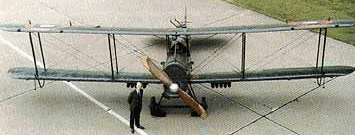 Following World War I, the DH-4, and its sister ships and successors by deHavilland, formed the backbone of early commercial aviation and military airpower throughout most of the flying world.
Following World War I, the DH-4, and its sister ships and successors by deHavilland, formed the backbone of early commercial aviation and military airpower throughout most of the flying world.
A successful tactical (short-range, close-in) bomber in the First World War, the DH-4 was one of the best for its day. Its powerful Rolls Royce or Liberty engine could drag the big 2-seat biplane bomber through the sky at over 140mph (faster than most of the fighters of the day). It initially earned a nasty reputation as the "Flaming Coffin" because of a big fuel tank placed hazardously between pilot and gunner, but the relocation of the tank reduced the danger and brought the plane a decent reputation. The heavy-hauling bomber was also used in early attempts to resupply troops by air. While airpower made little impact in the First World War, the DH-4 became a tool for developing airpower tactics for future wars (including combat airlift and airplane-to-airplane inflight refueling). Surplus DH-4's would find their way into many countries -- spreading military airpower around the globe.
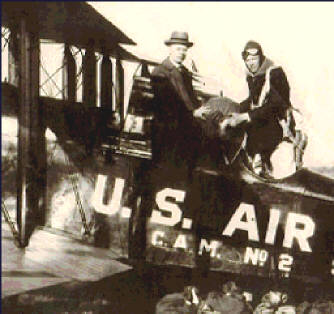
One of the more practical bombers of World War I, the DH-4 was the only World War I combat airplane that was built in large numbers in the United States (well over 3,000). By building thousands of the British-designed DH-4 biplanes, America began to build up the capacity of its own emerging aircraft-manufacturing industry.
After the war, the DH-4 was retired in vast numbers, which found their way into civilian hands -- becoming popular utility and cargo aircraft throughout Europe and America. The stout, powerful, fast DH-4 -- which had been designed to carry hundreds of pounds of bombs, while outrunning enemy fighters -- had capabilities of speed and payload that found quick acceptance in the post-war civilian world. Countless early pilots began their civilian careers in the cockpits of DH-4's -- carrying mail, cargo, and passengers. Among them was a young Charles Lindbergh, an airmail pilot (shown here loading the mail into his DH-4 for the first St.Louis-Chicago airmail flight).
 The relatively-reliable DH-4, able to carry hundreds of pounds over more than a thousand miles, was the main tool of America's early airmail service. As the first reliable aircraft for regularly scheduled air service, the DH-4 also gave rise to the first regular commercial cargo services. The early DH-4 airmail and cargo planes scouted out regular routes, which would become the basis of America's -- and the world's -- airways system. Among its firsts was the first non-stop transcontinental flight across the United States, in 1922, flown by Jimmy Doolitttle across 2,193 miles from Florida to California, in just 21 hours.
The relatively-reliable DH-4, able to carry hundreds of pounds over more than a thousand miles, was the main tool of America's early airmail service. As the first reliable aircraft for regularly scheduled air service, the DH-4 also gave rise to the first regular commercial cargo services. The early DH-4 airmail and cargo planes scouted out regular routes, which would become the basis of America's -- and the world's -- airways system. Among its firsts was the first non-stop transcontinental flight across the United States, in 1922, flown by Jimmy Doolitttle across 2,193 miles from Florida to California, in just 21 hours.
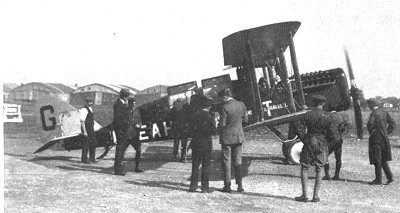 In 1919, a DH-4 began the first scheduled British airline service (shown at left), flying passengers in its rear cockpit (open at first), on the first scheduled airline service between Europe's leading capitals: London and Paris. Other such uses of the DH-4 would follow, throughout the world. These various developments, in turn, paved the way for the nationwide, and worldwide, expansion of passenger airline routes.
In 1919, a DH-4 began the first scheduled British airline service (shown at left), flying passengers in its rear cockpit (open at first), on the first scheduled airline service between Europe's leading capitals: London and Paris. Other such uses of the DH-4 would follow, throughout the world. These various developments, in turn, paved the way for the nationwide, and worldwide, expansion of passenger airline routes.
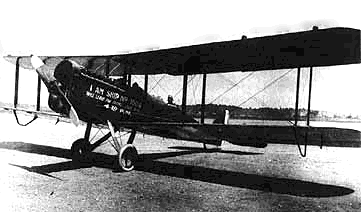 In short, then, despite its start as a lethal weapon of war, the DH-4 became one of the most remarkable and important civilian conversions of military weaponry in world history -- becoming the most important aircraft in the early development of civilian commercial aviation. As a footnote, though, it was also a milestone in the development of military aircraft.
In short, then, despite its start as a lethal weapon of war, the DH-4 became one of the most remarkable and important civilian conversions of military weaponry in world history -- becoming the most important aircraft in the early development of civilian commercial aviation. As a footnote, though, it was also a milestone in the development of military aircraft.
Why this plane stands out from its "peers."
While many other planes have been important, few others had nearly so pivotal an impact on aviation or on history. The DH-4 is an "indispensible"aircraft -- an aircraft with no significant concievable substitute available at its juncture in history.
The British Airco/deHavilland DH-4, and its sister ships and successors simply outnumbered the competition, and were better built than most of them. For basic quality, capacity and widespread availability, nothing else came close.
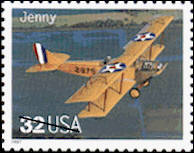 Though Americans are fond of citing the Curtiss Jenny (shown at right) in the same class, it was a far less productive plane -- with half the speed and much less load-capacity and range, when compared to the DH-4. The Jenny -- available cheaply in vast numbers as war surplus -- was more of a training, airshow and recreational aircraft, and used almost exclusively in the U.S. The Jenny's three claims to fame are...
Though Americans are fond of citing the Curtiss Jenny (shown at right) in the same class, it was a far less productive plane -- with half the speed and much less load-capacity and range, when compared to the DH-4. The Jenny -- available cheaply in vast numbers as war surplus -- was more of a training, airshow and recreational aircraft, and used almost exclusively in the U.S. The Jenny's three claims to fame are...
The Jenny, like other planes of the 1920's, was limited largely to training and entertainment -- while the real work of the "Golden Age" of American aviation was mainly being done, quietly and reliably, by the sturdy DH-4's.
For more information:
|